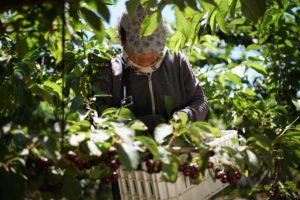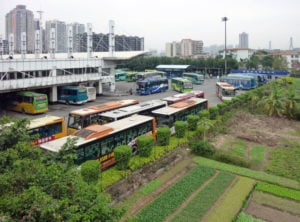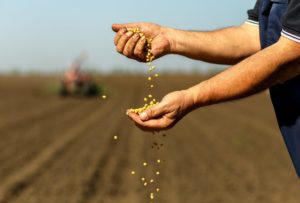“In Chile you have breakfast, lunch and you dream about avocado, but living in China it wasn’t easy to find,” says Camila Kemeny, a Chilean English teacher who lives in the eastern city of Hefei. “Lately I’ve been seeing more avocados, so I’m happy, because I’m always looking for them like crazy,” she added.
In recent years, imports of the “butter fruit”, as it is known in China, have exploded. Almost all come from Latin America. In 2017, China imported more than 32 thousand tonnes of avocado, 22% more than the previous year.
However, across the region, the surge in exports has been accompanied by conflict over water resources and deforestation.

Exactly half of China’s imports (16,707 tonnes) last year came from Chile, with 8,754 tonnes from Mexico and another 6,667 from Peru, according to calculations by UN Comtrade data.

These three countries have distinct economic advantages in supplying the Chinese market. Chile and Peru have free trade agreements with China and do not pay any export tariffs. Mexico accounts for around half of global avocado exports. It benefits from being much closer to the Chinese market than its competitors, meaning transport costs are lower.
“Fashionable fruit”
Big cities Shanghai, Beijing and Guangzhou, account for the largest share of demand, according to Ramón Paz, a spokesman for the Mexican Avocado producers & Packers Association (Apeam).
Paz, along with other experts, attribute the success of the fruit to the Chinese who travel abroad and to tourists introducing new culinary habits.
A young stallholder at Beijing’s Sanyuanli market told Diálogo Chino: “People weren’t accustomed to them at first, they thought they were just used for salad and sushi, but now they are more used to eating them and use them in their cooking or eat them for breakfast – like avocado on toast.”
With supposed health benefits, demand for the golden green fruit is booming the world over. Some new restaurants even promoted hamburgers enveloped in avocado instead of bread.
But demand did not arise spontaneously in China. The avocado was practically unknown ten years ago and the Chinese, who preserve culinary traditions with pride, did not accept the fruit at first.
News channel CGTN last year broadcast a special feature called “China’s avocado craze: a ‘superfood’ marketing success story”. The report argued that the arrival of the fruit was driven by promotional campaigns hailing its positive effects on the heart and skin and a desire to capitalise on its appeal in the West.
Latin American entrepreneurs have created industry associations, such as the Hass Avocado Committee in Chile and the Mexican APEAM, which have taken campaigns to China. The Mexican consulate sponsored a food festival in Guangzhou and Sanya (on Hainan Island) in 2015 to promote Mexican food and tourism.
“China is a huge market and as people become aware of the fruits we export and introduce as part of their diet, consumption will increase,” Roxana Quirarte Murguia, a consultant for the Chinese market at Mexico Food Connection told China Daily.
Major companies have also signed agreements to promote large-scale distribution. US company Mission Produce, Lantao, the main importer of avocados to China and distributor Pagoda, signed a cooperation agreement, creating new brand Mr. Avocado. The merged company distributes boxes in large supermarkets with tags that explain how to cut the fruit and how to prepare it for recipes for the Chinese New Year.
Last year fast food chain Kentucky Fried Chicken promoted its fried chicken sandwich and avocado-filled tacos using the image of Chinese singer Joker Xue sporting a bright green moustache, supposedly acquired by munching on their products.
Social and environmental challenges
Although the increase in exports to China helps Latin American economies and generates jobs, the environmental consequences are worrisome. The high level of water consumption required to obtain the avocados silky texture and the acreage needed to meet demand have wreaked havoc on land.

In Chile, the most serious problem is water. In the central avocado-producing province of Petorca, rivers have dried up. 2,000 litres of water are needed to produce a kilo of avocados, four times the amount needed to produce a kilo of oranges, according to Mexico’s National Institute for Forestry, Farming and Fisheries Research.
Rodrigo Mundaca, an activist and spokesperson for Modatima, the Defense Movement for Access to Water, Land and Environmental Protection, has directly accused agribusiness for the lack of water in surrounding communities.
Local farmers told an investigation by The Guardian that people are getting sick from the drought and must choose between cooking or washing, and going to the bathroom in holes or in plastic bags. All the while, big agri-businesses earn more and more.
Climate change is also increasing competition for scarce resources.
“In general, it has rained less in the last ten years and there are big irrigation problems,” explained Alex Martín, a grower who has been exporting avocado from Chile for more than 20 years.
In Michoacán state, which produces the majority of Mexico’s avocados, the crop has been grown excessively and is accused of contributing to deforestation. According to Greenpeace, in the absence of effective regulation delimiting forest conservation areas and few forest resources that can compete with the avocado, foliage is disappearing.
Even before the boom, the area set aside for avocado production grew from 31 thousand hectares in 1980 to more than 106 thousand hectares in 2009, according to the Secretariat of Agriculture, Livestock, Rural Development, Fisheries and Food (Sagarpa), a Mexican government body.
Between 1976 and 2005, 20,000 hectares of forest were lost in the municipalities of Charapan, Cherán, Los Reyes, Nahuatzen, Nuevo San Juan Parangaricutiro, Paracho, Peribán, Tancítaro, Tingambato, Uruapan and Ziracuaretiro. Between 2000 to 2005, forest loss is estimated to be 509 hectares per year.
There are efforts to counteract the negative impacts. According to APEAM, 425 hectares of forest have been reforested in Michoacán.
Beyond environmental problems, the avocado has even become a focus for organised crime in Michoacán. Cartels control large swathes of the business and encourage illegal planting. Without effective law enforcement, illegal activities seem set to cause an even greater impact as demand continues to grow.
Colombia is also seeking to export to China. At present, Colombian avocados still do not have permission to be traded on the Chinese market. However, the dramatic growth of consumption has alerted the authorities to its earning potential. Then minister of agriculture Juan Guillermo Zuluaga made a point of it on visiting Beijing last May to meet counterpart Han Changfu.
The Colombian Ministry of Foreign Trade said the avocado trade could have a positive impact on regions badly hit by years of coflict with guerrillas and other illegal armed groups. Avocado production in the regions of Antioquia, Caldas, Cauca, Quindío, Risaralda, Tolima and Valle del Cauca is on the rise. It could improve living conditions for thousands of people hoping for new opportunities in the period following the signing of the 2016 peace agreement.
“Colombia now depends in part on the European market and we need market diversification,” explained Ricardo Uribe, an entrepreneur who has been in the avocado business in Colombia for more than 19 years, who played down the risk that environmental problems seen elsewhere in Latin America would occur in the country.
“The Chinese market has features that do not compare to Europe, and Colombia has access to the Pacific Ocean to reach the Asia, so it could be very good for the country.”







![The sea ice and mountains in Spitsbergen, Svalbard during the Arctic summer [Image by: Josh Harrison/Alamy]](https://dialogue.earth/content/uploads/2018/11/arctic-summer-sea-ice-300x200.jpg)

